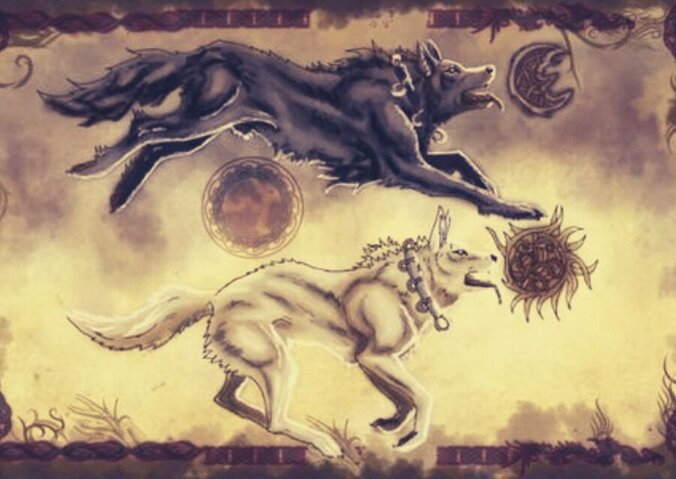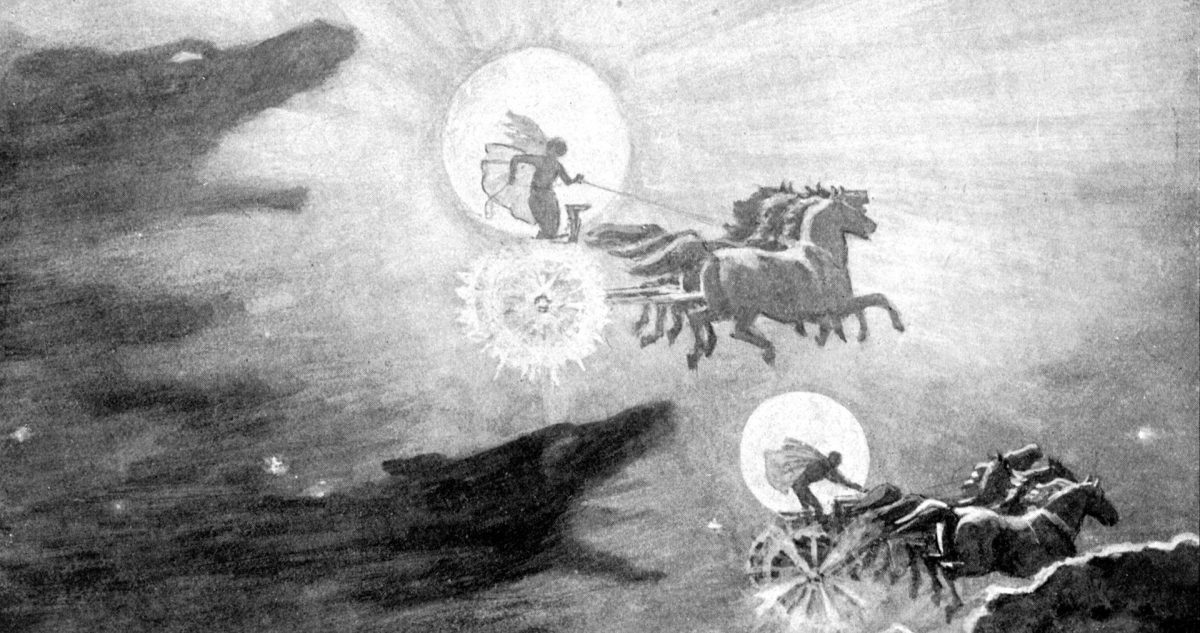Skoll and Hati are two giant wolf brothers famous in Norse mythology for their pursuit of the keepers of the Sun and the Moon, Sol and Mani.
The prophecy of Ragnarök, the Norse “End of Days,” decreed that they would one day succeed in capturing the chariots of the celestial bodies. This feat would result in the Norse realms plunging into darkness and disappearing in the ensuing chaos.
The Islandic politician, historian, and poet Snorri Sturluson states in the poem Grímnismál within the Poetic Edda that Skoll chases the sun and Hati the Moon.
What is the Pronunciation and Translation of Skoll and Hati?
The approximate pronunciation of Skoll (Old Norse: Sköll) is “skerl.” It is translated as “The treacherous or mocking one.”
Hati is pronounced “hah-tee” and means “the hater or enemy.”
Skoll and Hati’s Origin
Skoll and Hati are sons of Fenrir, arch-nemesis of the Æsir, and slayer of Odin in Ragnarök.
In typical Nordic fashion, Hati is sometimes anthropomorphically associated with the surname “Hróðvitnisson,” i.e., “son of Hróðvitnir.” Hróðvitnir means “famous wolf” and is an alias of the wolf Fenrir.
Fenrir, also known as Vánagandr, is the best-known wolf in Norse legend. He is the progeny of the trickster god Loki and the giantess Angrboda (sometimes called Íviðja or Iarnvidia), sibling of Hel, Queen of the Dead, and the poisonous World Serpent Jormungand (or Jörmungandr), which lies submerged encircling Midgard and awaiting Ragnarök.
The use of the surname Hróðvitnisson when talking about Hati in the poem Grímnismál from the Poetic Edda and Gylfaginning in the Prose Edda suggests he is the son of Hróðvitnir, more commonly known as Fenrir.
The Völuspá, another poem from the Poetic Edda, tells how the children of Fenrir swallow the sun during Ragnarök.
Hati’s mother is a giantess mentioned in the Völuspá. She is described as “fostering Fenrir’s kin,” possibly meaning she wasn’t their biological mother. The giantess lives in a forest called Járnviðr (“Ironwood”), which lies east of Midgard. She gives birth to giant wolves, including Hati and Skoll.
In further verses, one of her sons (unnamed) is prophecized to devour the moon and eat the flesh of the dead, scattering blood across heaven. However, Vafþrúðnismál, a poem from the Poetic Edda, describes Fenrir as the one who will destroy the sun.
Sturluson also provides the additional name Mánagarmr (“Moon-Hound” or “Moon’s Dog”) for a wolf who tries to catch the moon.
Who are Sol and Mani?
There are many versions of why the wolves chase Sol and Mani across the skies. Some sources suggest they were placed in the sky to mark the passage of time and give order to the World by providing day and night.
Others suggest they were the children of a mortal who angered the pantheon by saying his children were the equal of the gods in their beauty and gave them the sun’s and moon’s names.
Odin decided to give the brother the task of occupying the sun chariot while his sister rode the moon chariot, providing the skies with light and dark.
However, the pair were not very diligent in their work. Loki suggested to Odin that he use Skoll and Hati to chase them whenever they faltered and ensure the proper order was kept in the heavens.
Odin had captured the pair after they tried to free their father, Fenrir, who Odin had imprisoned.
The Prose Edda states that a shield bearer called Svalinn rode beneath Sol using her shield to prevent the heat from the sun from destroying Midgard.
The pair rode through the heavens on horse-drawn chariots. The two horses pulling Sol’s horses are called Alsviðr (or “Swift”) and Árvakr (or “Early Riser”); Mani’s horses are unnamed.

Are Sköll and Hati Norse Gods or Something Else?
The pair are never named as gods, although their father, Loki, is one of the best-known gods of the pantheon, so they are at least demigods.
Are Hati and Skoll Male or Female, and Are They Twins?
There is no record of Hati and Skoll being twins, and it is unclear whether Hati is female.
One source claims that Hati is usually referred to as male because of a mistake in a 15th-century English translation.
What do Skoll and Hati Symbolize in Norse Mythology?
In Scandinavian myth, wolves were symbols of death and destruction. As time passed, they began to symbolize something more positive like life cycles, a balance of the present replacing the past.
This philosophy would tie in with the concept of Ragnarök, i.e., the destruction of an old world and the dawn of a new one.
In some cultures, they are regarded as yin and yang-like figures as they symbolize a universal balance between light and dark or day and night.
Are Hati and Sköll Evil?
Some sources describe Skoll as quiet and unhappy at being put to work chasing Sol and Mani, although he tolerated the task as it was better than imprisonment.
Hati Hróðvitnisson was more outgoing, mischievous, and cheerful, although they had a severe temper.
Hati disliked his job of chasing the chariot but realized one day, when Ragnarök happened, they would be free.
What are the Colors of Sköll and Hati?
The colors of Skoll and Hati’s fur have been taken to symbolize the cycle of birth and passing. Skoll’s black fur signifies death, while Hati’s red fur means life.
Some sources indicate that Skoll was black with red symbols on his back, had red eyes, and a sun on his forehead.
Hati was white and had blue eyes. It had bright blue shapes on its back and a moon on its forehead.
Skoll and Hati Attestations in the Poetic Edda and Prose Edda
Sturluson describes in the Prose Edda that Skoll chases the sun and Hati the moon.
However, the poem Grímnismál from the Poetic Edda states the following:
Skǫll heitir úlfr,
er fylgir eno skirleita goði
til varna viðar;
en annarr Hati,
hann er Hróðvitnis sonr,
sá skal fyr heiða brúði himins.Skoll is the name of the wolf
The History of Skoll and Hati – Culturale Exchange Blog
Who follows the shining priest
Into the desolate forest,
And the other is Hati,
Hróðvitnir’s son,
Who chases the bright bride of the sky.
“goði” or “priest” is a masculine noun, and “brúði” or “bride” is feminine. Since Norse myth depicts Sol, the sun, as female and Mani, the moon, as male, this stanza might indicate that Skoll chases the moon while Hati pursues the sun.
Why do People Get Tattoos of Sköll and Hati?
Apart from the apparent attraction of two giant wolves from Norse mythology chasing chariots pulling the sun and moon, the symbolism is incredibly alluring too.
Wolves are pack animals, but the expression “lone wolf” is also a part of our diction – two more strong images.
Another example of symbolism parallel to the wolves is the battle between light and dark, death and rebirth, day and night, and yin and yang.
Do Hati and Skoll Appear in any Modern Video Games?
- Hati appears in Assassin’s Creed: Valhalla.
- There are murals of Skoll and Hati in Tyr’s vault in God of War (2018).
- Hati and Skoll are world bosses in Ark Fjordur from Ark Survival Evolved.

